The awesome beauty of New Zealand's skyscape, and the drama that unfolds in and beneath it, makes a captivating subject for this series of six stamps, which commemorated New Zealand's natural beauty.
Issue information
For this issue, photographers captured the clear blue skies and dramatic sunrises and sunsets that form the canopy above New Zealand. The beauty, grandeur, drama and light of each photograph was absorbing and inspiring, and a tribute to the skills and vision of those who captured these moments on film.
For the 40c stamp, Derek Morrison captured the grace, richness and awesome power of the sun, as it crept above the horizon near Cambridge to bathe Waikato farmland in light.
Robert E Wells' lens found a rare moment of reflection on the surface of Lake Wanaka for the 80c stamp. Lake Wanaka holds perfectly still just for a moment, to allow a photograph from the rod to Treble Cone skifield.
Wayne Tait's patience was rewarded with a picture-perfect end to what had been just another dull winter's day as the sun set over Mount Maunganui for the $1.00 stamp.
The $1.20 stamp showed us Nathan Secker's view from the launching ramp at South Bay in Kaikoura on a day when northwest conditions created a warm light just perfect for a shot of a wonderfully calm sea.
The $1.50 stamp featured a seldom-seen perspective, by Cam Feast, of the statue of Wairaka which stands on top of one of the rocks at the channel entrance of Whakatane Harbour in the Bay of Plenty.
Finally, unusual cloud formations hover above Lindis Pass just before sunset as the sun drops behind the Southern Alps, in a scene photographed by Nathan Secker and featured on the $1.80 stamp.
The beauty, grandeur, drama and light of each photograph were absorbing and inspiring, and a tribute to the skills and vision of those who captured these moments on film. Perhaps now, prompted by these reminders of what happens in the sky somewhere in New Zealand on almost a daily basis, New Zealanders will look up more often.
Product Listing for 1998 Scenic Skies
| Image | Title | Description | Price |
|---|---|---|---|
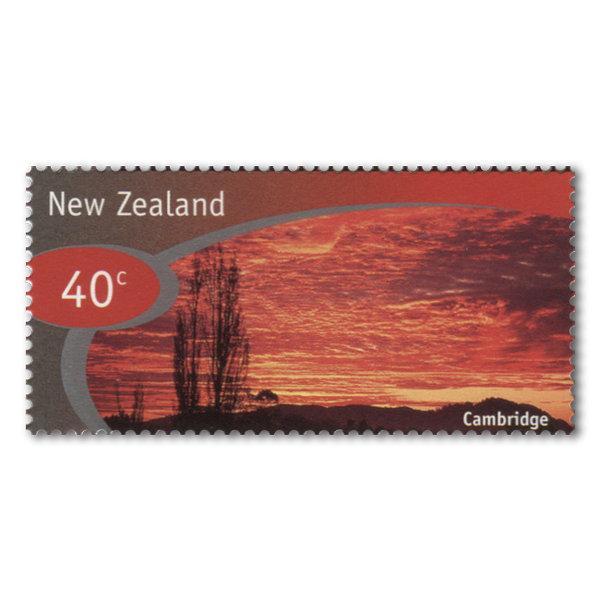 |
Single Stamp |
Single 40c 'Cambridge' gummed stamp. As the dairy farmer walked through his herd, a bright red light burns in his eyes and he raises his head to the skies in the east. Ten thousand candles burned brightly on the horizon as he moved to the fence to watch the spectacle of fire and earth. His eyes were wide as he stared at the grace, the richness and the power of nature, as she unveiled the landscape with her proudest performance. The dairy farmer was captivated by the sheer revelation in the light show that signalled the change from darkness to light. Cambridge itself, is a charming town on the Waikato River, and is characterised by the large number of trees planted by the early settlers. The town is surrounded by generally level country, which is highly developed for dairy, sheep and cattle farming. The area is also famed for its racing stables and studs, the progeny from which are widely sought after. |
$0.40 |
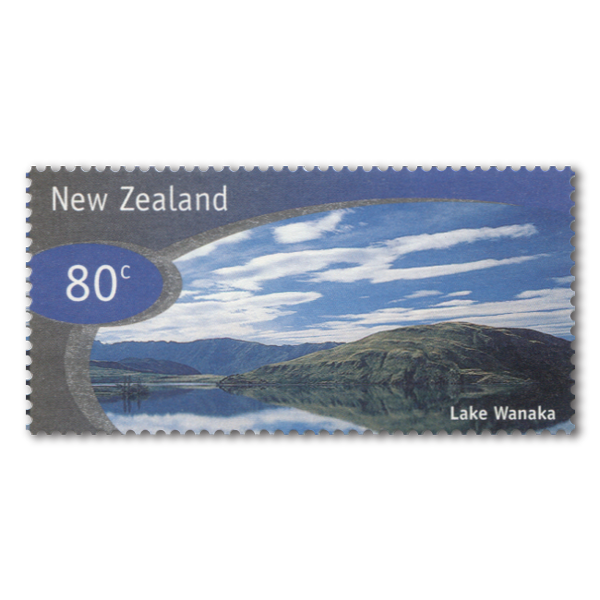 |
Single Stamp |
Single 80c 'Lake Wanaka' gummed stamp. Lake Wanaka is one of the largest of the South Island lakes and one of the source lakes of the Clutha River. The lake is walled by mountains throughout its length of 48 kilometres and, as elsewhere in the region, poplar and willow trees line the Lake's edge, making autumn a colourful time to visit. Wanaka is a year round destination for thousands of holiday makers, both local and overseas, who to there to boat, fish, swim and waterski as well as explore the Mount Aspiring National Park whose headquarters are in the town. The scene is from the road to Treble Cone Skifield where the road skirts around below high cliffs on the left and a very steep drop to the Lake some 100 metres below. Reflections like this one, so very, very rare, are a goldmine for any photographer. Even on the calmest days the Lake surface seems to shimmer, breaking up any reflections. From the summit of this climb the road winds down to the valley floor, level for the next 20 or so kilometres except where it drops down to cross the Mototapu River. The River is a very popular spot for fishing, camping and picnics and rock climbers are almost always to be found on the cliffs. In autumn the Mototapu River valley, with varying shades of golden trees and distant mountains, make a glorious colour picture, the best one on the road. |
$0.80 |
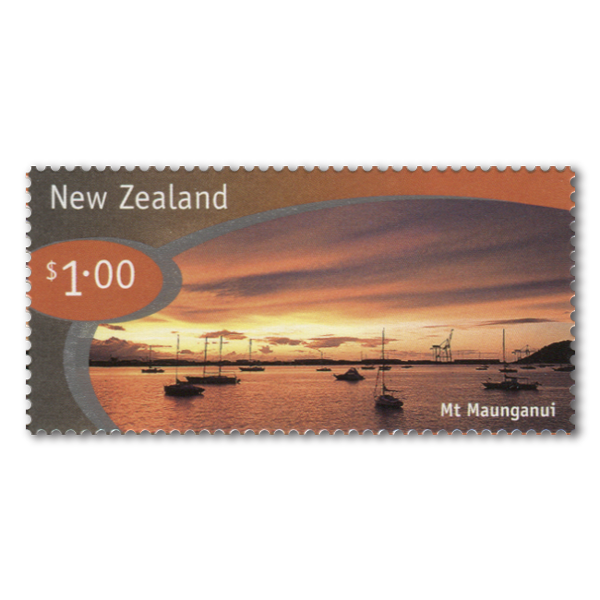 |
Single Stamp |
Single $1.00 'Mount Maunganui' gummed stamp. The image was taken from Mount Maunganui looking over Tauranga during the winter of 1996. It had been a dull winter's day when the sun poked through the cloud. This reflected in the water; the boats added some interest and perspective to the foreground. The photographer Wayne Tait was travelling back to Tauranga at the end of the day and could see what was about to happen. He set up his tripod, managing to get a few frames off before the light disappeared. The Port of Tauranga, with its main docks on the inside of the Mount Maunganui peninsula, is a major export port. It handles pulp, paper, timber and a wide range of other primary products from the rich Bay of Plenty region. Mount Maunganui which means 'Big Hill', was once a Māori fortress and it is said that it remained impregnable for more than 100 years. A track leads to the summit from where there is a magnificent view. |
$1.00 |
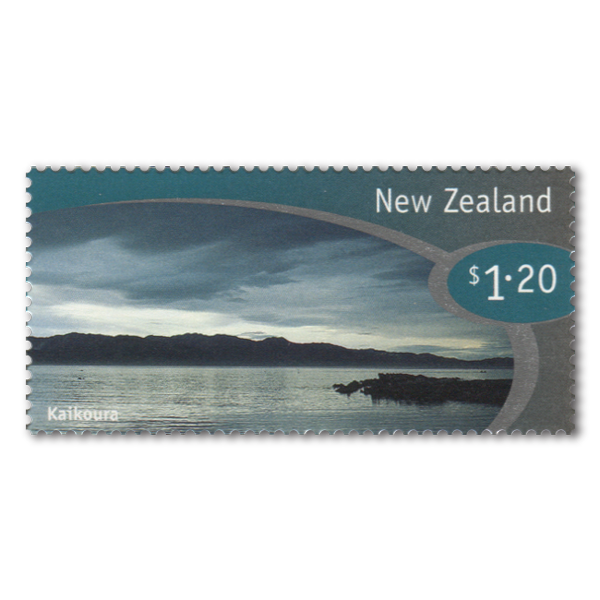 |
Single Stamp |
Single $1.20 'Kaikōura' gummed stamp. This photograph was aken at the end of a day's dolphin and whale watching of Kaikōura. This is a view from the launching ramp at South Bay on a nor'west evening. Owing to the ocean shelf dropping to 1,500 metres within 1.5 kilometres from the shore, sperm whales, in particular, are drawn close to the coast by the rich food supply. Nor'west conditions inland can make for calm sea conditions and warm light perfect for photography. Kaikōura offers many photogenic opportunities with an abundance of wildlife. It also provides some of the best surf conditions in the country. Kaikōura is almost halfway between Christchurch and Picton on the South Island's east coast. Backed by the Seaward Kaikōura Range, the Kaikōura Peninsula affords a magnificent view of the mountain chain rising from the ocean to heights of over 2,000 metres. The beginnings of European settlement in the area are linked to shore whaling activities in the early part of last century. Kaikōura is today again experiencing an economic boom in whale watching, by visitors from all over the world who come to observe rather than slaughter these magnificent creatures. |
$1.20 |
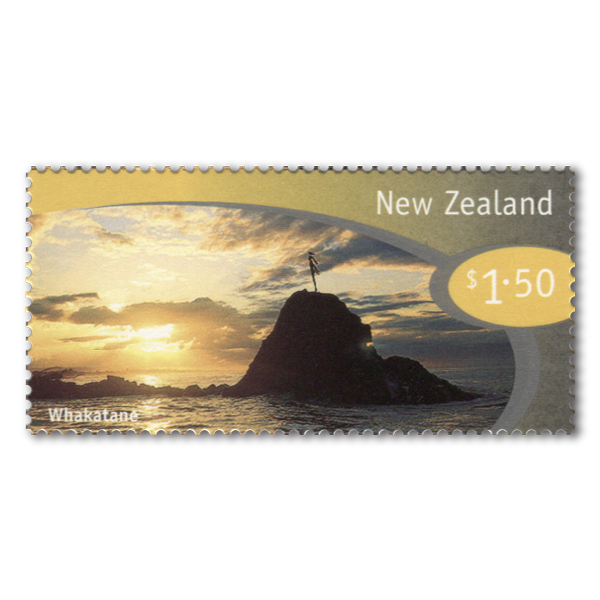 |
Single Stamp |
Single $1.50 'Whakatane' gummed stamp. This photograph is of the statue of Wairaka, atop one of the rocks at the channel entrance of Whakatane Harbour in the Bay of Plenty.According to Māori legend, Wairaka save the Mataatua waka (canoe) from drifting out to sea after the men had gone ashore. Taking a paddle she cried "Kia whakatane ahau i ahau" ("I will make myself a man") and commenced to paddle, a responsibility usually reserved for men. With the help of other women Wairaka steered the waka safely to shore. The statue stands as a memorial to her courage. The Bay of Plenty is appropriately named for the abundant life that can be found in its waters. Dolphins and tuna can be seen chasing schools of fish, and several species of whale are common. At the end of the day's filming of a pod of 50 sperm whales in the bay, the photographer Cam Feast, managed to get some footage with an underwater pole camera system. Not many days were like that for them, often they would have perfect weather and spend the whole day from dawn to dusk travelling with their eyes focused on the water looking for a telltale puff of spray or splash amongst the glare. Cam grabbed his still camera as they rode a gentle swell over the bar back into the Harbour. With the sun setting, and after seeing the perspective from the water with the sun and sky behind, he was convinced that the view conveyed more about the place and the statue than any other. |
$1.50 |
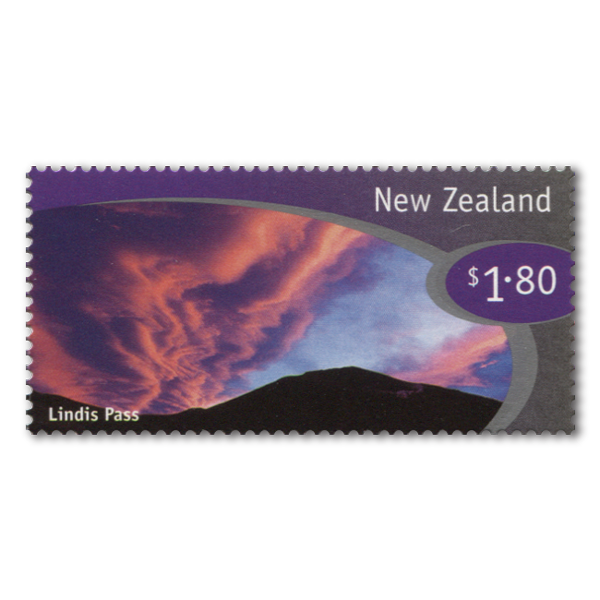 |
Single Stamp |
Single $1.80 'Lindis Pass' gummed stamp. This was an opportune photograph taken by the photographer Nathan Secker whilst he was returning from a photographic assignment at Milford Sound. He could see strange cloud formations hovering above Lindis Pass form about 30 kilometres out and it became a race against time to arrive before the sunset. The lookout at the top of the Pass presented a stunning view of the north of clouds, which resembled UFO's hovering above the tussock-clad hills (owing to a northwest airstream). To the south, there was a buildup of cloud which, as the sun set, was to become the photograph on the stamp. Almosts immediately on setting up the tripod, Nathan began to get buffeted by gusts of southwest wind of up to 40 knots. These gusts presented a major difficulty in keeping the camera steady for the relatively long shutter speeds required for the photographs. As the two weather fronts fought each other and the sun dropped behind the Alps there created, for too short a time, some images that are still etched in the photographers memory. The Lindis Pass, with an altitude of 1,000 metres, links the Waitaki basin with Central Otago. In pre-European times a well known Māori track led over the Pass from Lakes Wanaka and Hawea down the Waitaki River valley to the coast. |
$1.80 |
 |
First Day Cover | First day cover with stamps affixed. Cancelled on the first day of issue. | $7.20 |
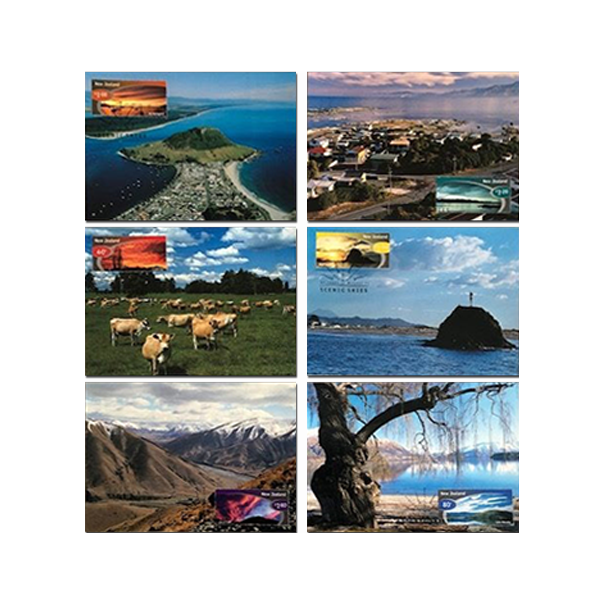 |
Set of Maximum Cards | Set of six pre-paid postcards featuring a stamp on the front and artwork from the stamp issue. | $7.95 |
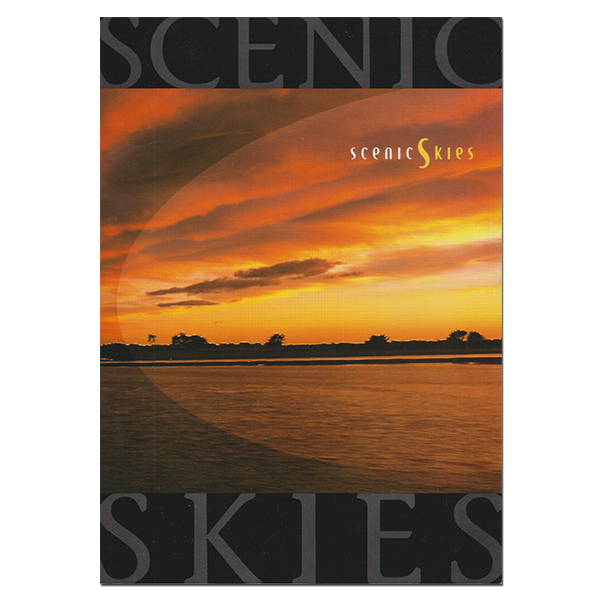 |
Presentation Pack | Presentation pack containing a selection of stamp products from the issue and further information on the theme of the stamps. | $8.50 |
Technical information
| Date of issue: | 29 July 1998 |
|---|---|
| Number of stamps: | Six |
| Denominations and designs: | 40c Cambridge; 80c Lake Wanaka; $1.00 Mount Maunganui; $1.20 Kaikōura; $1.50 Whakatane; $1.80 Lindis Pass |
| Stamps and first day cover designed: by | Cato Design, Wellington, New Zealand |
| Printer and process: | Southern Colour Print, Dunedin, New Zealand by lithography |
| Number of colours: | Four process and one common special colour |
| Stamp size and format: | 50mm x 25mm (horizontal) |
| Paper type: | 103gsm gummed red phosphor coated paper stamp paper |
| Number of stamps per sheet: | 40 |
| Perforation gauge: | 14 |
| Cost of unadressed first day covers: | $7.20 |
| Special blocks: | Plate/imprint, positional or value blocks could be obtained by purchasing at least six stamps. Colour blocks ('traffic lights') were included in plate blocks. Barcode blocks were available in both A and B formats. |
| Period of sale: | These stamps remained on sale until 29 July 1999. |

